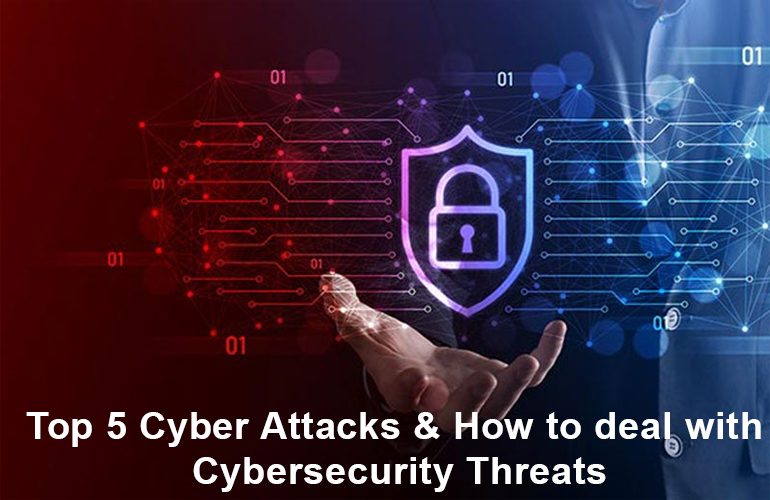Top 5 Cyber Attacks & How to deal with Cybersecurity Threats
As we become more connected and reliant on digital tools, we expose ourselves to a multitude of threats that were previously unimaginable. From phishing scams to malware attacks, cybercriminals are constantly evolving their tactics. The stakes are high, and businesses all over the world are feeling the pressure to protect their data and customers.
However, it’s not just about the financial implications. Cyber-attacks can also have an impact on our sense of security. We live in an age where our personal information is readily available online. The thought of it falling into the wrong hands is enough to keep anyone up at night. That’s why it’s crucial to stay informed and take a proactive approach to cybersecurity.
The reality is that cyberattacks aren’t going anywhere, and they’re only going to become more sophisticated in the years to come. That’s why businesses need to be equipped with multi-layered security measures to defend against these threats. Whether it’s through educating employees on best practices or implementing the latest technology solutions, we all have a role to play in keeping our digital world secure. Here are some common types of cyber attacks:

- Ransomware: A ransomware attack can affect anyone. Once it infiltrates a system, it encrypts the victim’s files and demands payment in exchange for the decryption key. Such attacks can come through email attachments, software vulnerabilities, or even seemingly harmless websites. That’s why it’s crucial to stay vigilant and take preventative measures. Regularly backing up your files to an external hard drive or cloud storage service can pay off in the long run. Keeping your operating system and software up-to-date can also provide an added layer of protection against known threats. Enhancing email security by deploying sophisticated email protection & email filtering and multifactor authentication.
- Phishing: Have you ever received an email that looked like it was from your bank, asking you to update your login credentials? Or perhaps a message from a social media site, requesting that you reset your password? These seemingly harmless requests could actually be a phishing attack which is becoming increasingly common. Phishing attacks are designed to trick individuals into divulging sensitive information, such as login credentials, credit card details, or other personal information. Being alert, putting procedures in place to verify the sender as well as the message can make a difference.
- MITM: With Man-in-the-Middle (MITM) attacks, cybercriminals can intercept communication between two parties to steal information or modify messages without either party realising it. This gives them full access to the sensitive information being exchanged. So, how can you protect yourself against these stealthy attackers? Using secure communication channels, such as encrypted messaging or secure websites (HTTPS), makes it harder for the attacker to intercept and understand the information being exchanged. Additionally, verify the identity of the other party before sharing any sensitive information. You can also use a Virtual Private Network (VPN) when connecting to public Wi-Fi networks, as these networks are often vulnerable to MITM attacks.
- DDoS Attacks: Distributed Denial of Service (DDoS) attacks work by bombarding a website or network with an overwhelming amount of traffic, causing it to crash or become inaccessible to its intended users. This type of cyber attack is often carried out using a network of compromised computers, known as a botnet. Techniques such as strengthening all internet-facing devices to prevent compromise, installingintrusion detection systems &firewalls configured to protect against DoS attacks; following strong security practices to monitor and control fake traffic;placing computer resources behind Content Distribution Networks (CDNs) or Load Balancers and restricting direct Internet traffic to certain parts of your infrastructure like your database servers.Installing the best anti-virus and anti-malware software.
- SQL injection attacks: Simply put, these attacks exploit weaknesses in web applications to gain unauthorised access to your valuable data. Hackers use crafty techniques to inject malicious code into your website’s input field, allowing them to bypass authentication measures and sneak into your database. However, there are steps you can take to minimise the possibility of such situations. With secure coding practices, including input validation and parameterized queries, you can shield yourself from these malicious attacks. Ensure that your software and operating systems are updated and use a Web Application Firewall (WAF) to safeguard against SQL injection attacks.
How to deal with Cybersecurity Threats:
With the rise in cybersecurity threats, being prepared can make a huge difference. Often, it can be difficult to know where to begin taking steps to protect yourself online. Here are some of the steps you can take to protect yourself as well as your business:
- Spot Suspicious Activity: For businesses, the first line of defence against cybercrime is a well-trained team. Help your employees spot and avoid potential threats. Security Awareness training is highly recommended for all business staff.
- Strengthen Authentication Methods: Be sure to use strong passwords and two-factor authentication, allowing only authorised users the access to sensitive information.
- Anti-Malware and Anti-Virus Software: Up-to-date antivirus software and firewalls also contribute to protecting your network from potential threats.
- Data backup: Another easy step is to regularly back up your data and store it in a secure location which minimises the risk of a cybersecurity attack.
- Encryption: It’s best to use encryption for protecting confidential data and financial transactions.
By staying up-to-date on the latest cybersecurity threats and best practices, you can be confident that you’re better prepared to deal with any potential attacks. If you need help with your managed IT security, MSP Corporation is considered the best in the business. As a leading IT managed service provider in Sydney and all capital cities around Australia, MSP Corporation have the expertise to protect your business. To contact MSP Corporation, Ph: 1300 554 404 or email sales@mspcorp.com.au for more information.


 Australia's No.1 Managed Service Provider for Quality, Value and Service
Australia's No.1 Managed Service Provider for Quality, Value and Service
